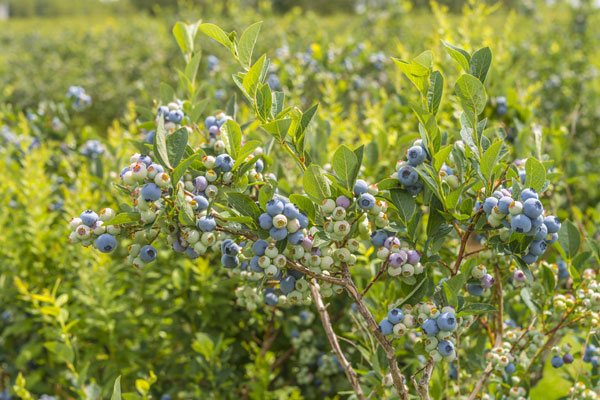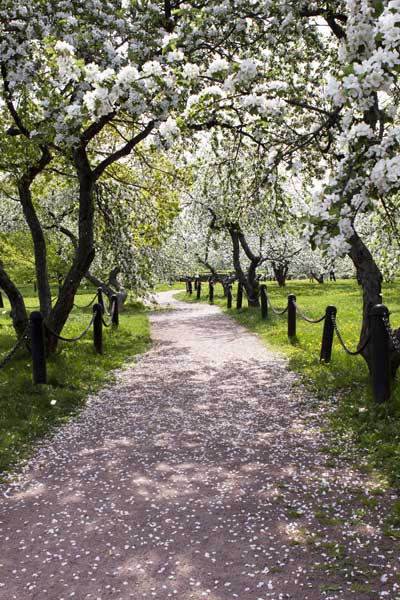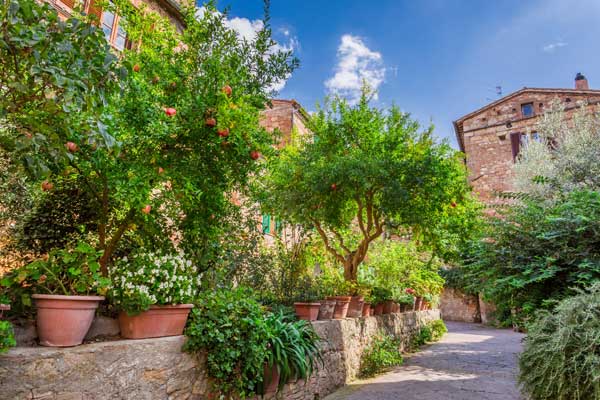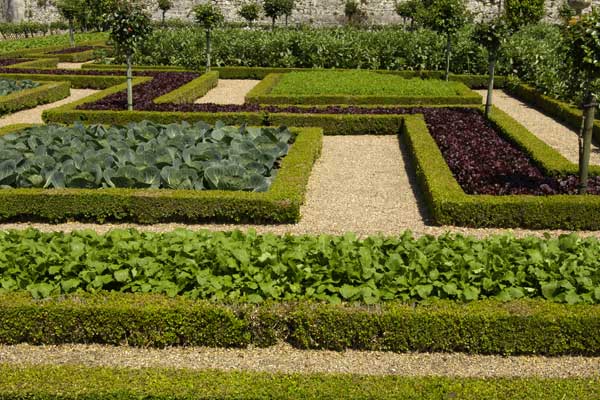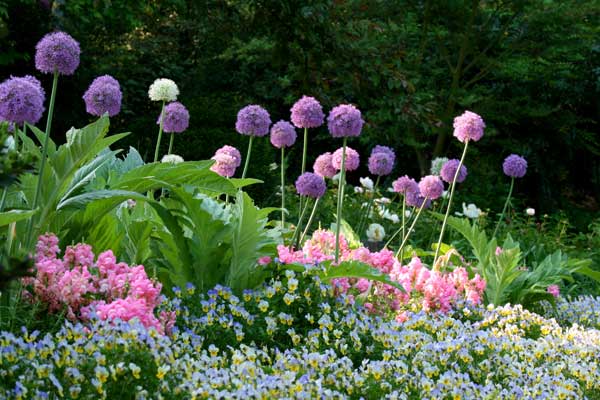This fall, try an apple tree instead of a dogwood or a row of blueberry bushes instead of hydrangeas.
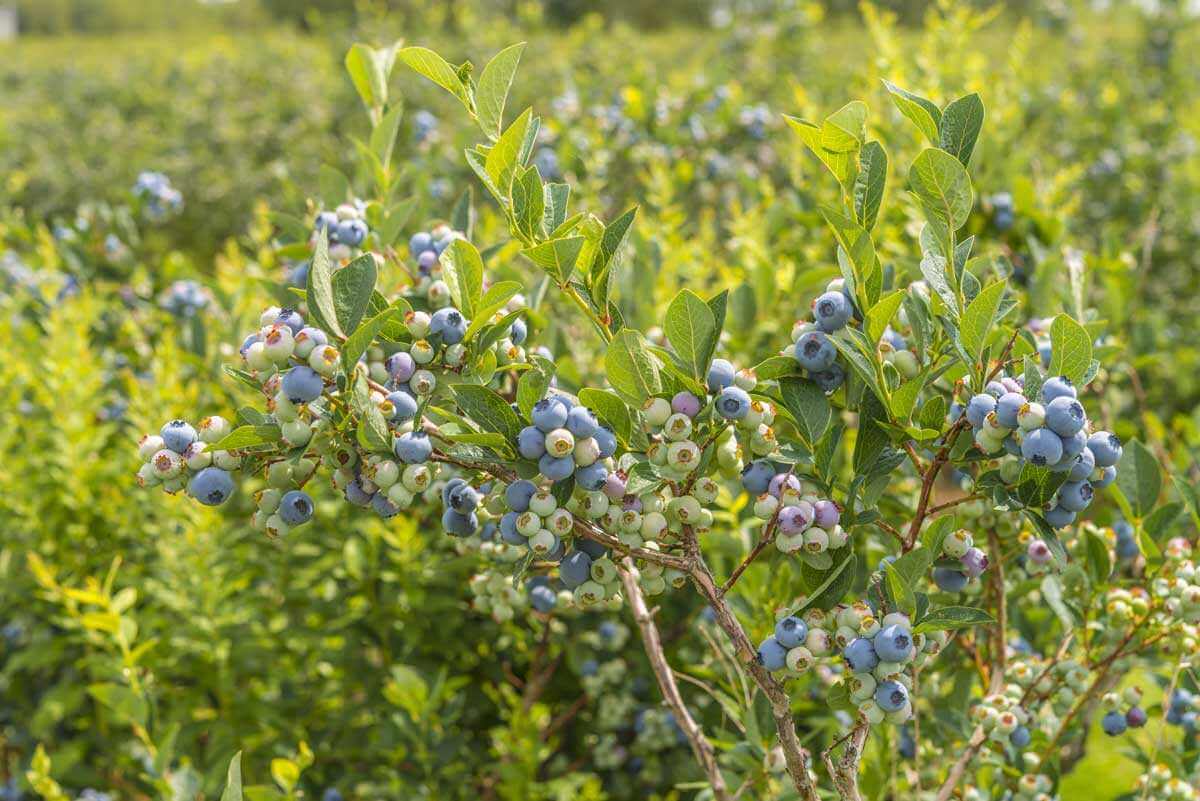
Integrating food plants throughout your landscape – as opposed to confining them to rows in the back corner of the yard – requires thinking about them in a different way. The easiest approach is substitution: For a large deciduous shade tree, consider a pecan instead of an oak. Want to plant a row of small trees with showy spring flowers along the front fence? Try fruiting cherries instead of the fruitless ornamental ones. Naturally, not all plants grow in all places, so check your USDA zone before purchasing any plants.
[mf_h2 align=”left” transform=”uppercase”]1. Berry Hedge[/mf_h2]
Blueberry bushes (USDA zones 3 to 10, depending on the variety) provide more than just fruit; they can also screen off the yard from neighbors or add a bit of greenery to the walls of your house as a foundation planting. They have a tidy, dense growth habit and from a distance look like any other of a dozen common hedge plants. Up close, the delicate urn-shaped white flowers in spring, and the powder blue berries in fall are undeniably beautiful. For the best fruit production, plant more than one variety (for the sake of pollination), so choose two varieties that grow to the same size (they range from 2 feet to 10 feet in height) for a consistent hedge. However, there a few varieties that are self-fertile (so only one variety is required) and have been bred for both ornamental beauty and fruit production, such as ‘Pink Icing‘, which has attractive pink-tinged foliage in spring.
[mf_h2 align=”left” transform=”uppercase”]2. Apple Allée with Herbs[/mf_h2]
An allée is a planting of parallel rows of trees on either side of a path, driveway, or road. By using apple trees (USDA zones 3 to 10, depending on the variety) for an allée – which have delicate pink-tinged blossoms that emerge on their still bare branches in March and April – you’ll have a magical tunnel filled with flower petals in early spring and fruit to fill your cupboard with in late summer and early fall. Dwarf apples cast little shade around them, allowing you to plant beds of rosemary, lavender, and sage beneath them – these herbs attract the honeybees needed to pollinate the apple blossoms, as well as providing a harvest of their own. More than one variety of apple is required for cross-pollination, but not all varieties pollinate each other, so consult a pollination chart to make sure you choose compatible varieties.
[mf_h2 align=”left” transform=”uppercase”]3. Mediterranean Oasis[/mf_h2]
Olives (USDA zones 9 to 11), figs (USDA zones 7 to 11), and grapes (USDA zones 4 to 10, depending on the variety) make fantastic culinary combinations, but they also work well together in the landscape. They originate in the dry, rocky hills of the Mediterranean Basin, so they’re a good choice for an area with poor soil, as long as it’s well-drained. Their only drawback is lack of cold tolerance – grapes tolerate subzero temperatures, but olives suffer frost damage below 20 degrees Fahrenheit, and figs die back to their roots around 10 degrees Fahrenheit. Olives have delicate grey-green leaves and gnarled trunks with age; they can be trained as trees or maintained as an evergreen hedge. Figs have enormous leaves with an iconic shape and will grow as a tree or shrub. Grapevines are a classic plant for training over an arbor or a pergola, creating a shady oasis for an afternoon meal. All three are self-fertile.
[mf_h2 align=”left” transform=”uppercase”]4. Vegetable Parterre[/mf_h2]
Vegetable beds have a reputation for being unruly and are a part of the landscape that is often screened off from view. It doesn’t have to be that way, however; it’s all a matter of how you frame them. One approach is to model your vegetable garden on the idea of a French parterre garden, a formal garden design where beds are neatly delineated in a symmetrical shape. The basic parterre garden has four rectangular beds with a circular bed in the middle, though there are many variations on this theme. The beds may be edged in stone for a crisp, clean border, but are more commonly edged with a short, tightly sheared hedge. These were traditionally flower gardens, but there is no harm in breaking the rules and filling them with veggies. Use decorative gravel for the pathways, plant an evergreen herb (like sage, rosemary, or lavender) for the border, and surround the area with a low picket fence for a quaint, tidy, and productive vegetable garden. Build the garden now and plant your fall seedlings at least one month before the first frost date in your area, or build it in fall and plant your veggies in spring.
[mf_h2 align=”left” transform=”uppercase”]5. Edible Flower Border[/mf_h2]
Flower gardens can provide more than food for hummingbirds, butterflies, and bumblebees – many flowers are edible and make a dainty addition to salads and other dishes. Nasturtium, calendula, pansies, borage, marigolds, and daylilies are a few of the tastiest, but there is a long list to choose from, including many cool weather annuals and perennial species suitable for fall planting. Just be sure of what you’re picking, since some flowers are also poisonous. There is no reason to stop short of adding some of the more colorful vegetables to your flower border either. ‘Trout Back’ lettuce is a treat with its tender, speckled leaves, whether in the kitchen or mixed in a bed with small flowers like pansies and phlox; cayenne peppers light up a border with their firecracker-like fruits and mix well with taller perennials like black-eyed Susan’s and bee balm; artichokes are a wild choice for the back of a flower border where their enormous grey-green leaves eventually erupt with artichoke buds and then purple, thistle-like flowers up to 4 feet tall.
